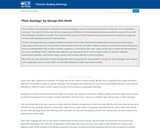
The scientific community must be effective in communicating the results of its work to the public in a way that can be understood and used. The need for this is acute, for the complexity and difficulty of environmental and resource problems require full use of all the knowledge scientists can muster. The wisdom of the actions of both the government and private sectors depends in large part on their understanding of resource characteristics.
The U.S. Geological Survey is uniquely qualified to provide much of the required knowledge about natural resources through its many reports and maps and can be proud of the products of its work. Too often, however, reports are couched in words and phrases that are understandable only to other scientists, engineers, or technicians. But, who, really, are the ones to whom the Survey wishes to convey its findings? Other scientists and engineers, yes. But beyond them, by far a larger audience: teachers, students, businessmen, planners, and Federal, State, county, and municipal officials–in short, the public.
More than 50 years ago former Director George Otis Smith recognized the same problem. His plea for “Plain Geology” was a classic, just as applicable now as it was in 1921. It is herewith reprinted to make it generally available.
persuasion example
- Subject:
- Composition and Rhetoric
- English Language Arts
- Geology
- Physical Science
- Material Type:
- Reading
- Provider:
- Lumen Learning
- Author:
- George Otis Smith
- Date Added:
- 06/05/2019